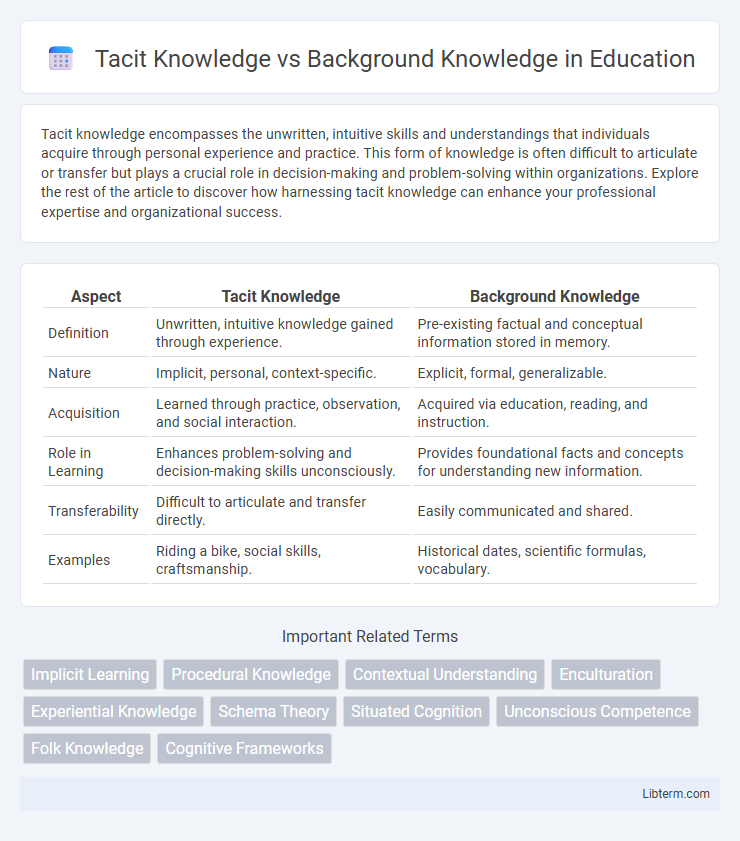Tacit knowledge encompasses the unwritten, intuitive skills and understandings that individuals acquire through personal experience and practice. This form of knowledge is often difficult to articulate or transfer but plays a crucial role in decision-making and problem-solving within organizations. Explore the rest of the article to discover how harnessing tacit knowledge can enhance your professional expertise and organizational success.
Table of Comparison
| Aspect | Tacit Knowledge | Background Knowledge |
|---|---|---|
| Definition | Unwritten, intuitive knowledge gained through experience. | Pre-existing factual and conceptual information stored in memory. |
| Nature | Implicit, personal, context-specific. | Explicit, formal, generalizable. |
| Acquisition | Learned through practice, observation, and social interaction. | Acquired via education, reading, and instruction. |
| Role in Learning | Enhances problem-solving and decision-making skills unconsciously. | Provides foundational facts and concepts for understanding new information. |
| Transferability | Difficult to articulate and transfer directly. | Easily communicated and shared. |
| Examples | Riding a bike, social skills, craftsmanship. | Historical dates, scientific formulas, vocabulary. |
Understanding Tacit Knowledge
Tacit knowledge refers to the unspoken, intuitive insights and skills gained through personal experience, often difficult to articulate or transfer. Understanding tacit knowledge involves recognizing its subtle influence on decision-making, problem-solving, and expertise within various fields such as craftsmanship, leadership, and innovation. Unlike background knowledge, which consists of explicit information and facts, tacit knowledge is deeply embedded in individual cognition and social interactions, making it a crucial asset for organizational learning and competitive advantage.
Defining Background Knowledge
Background knowledge encompasses the accumulated facts, information, and understanding that individuals possess prior to encountering new experiences or learning situations, serving as a cognitive framework for interpreting and integrating new information. It includes explicit knowledge acquired through education, reading, and formal instruction, as well as implicit knowledge gained from cultural, social, and environmental exposure. This foundational knowledge significantly influences comprehension, problem-solving, and the ability to connect novel concepts with existing mental schemas.
Key Differences Between Tacit and Background Knowledge
Tacit knowledge consists of personal, context-specific skills and insights that are difficult to articulate or transfer, often gained through direct experience and practice. Background knowledge refers to explicit, easily communicated information and facts that provide foundational understanding within a particular domain. The key difference lies in tacit knowledge's implicit, unspoken nature versus background knowledge's explicit, documented form.
The Role of Tacit Knowledge in Learning
Tacit knowledge plays a crucial role in learning by enabling individuals to acquire skills and understandings that are difficult to articulate or codify, such as intuition, judgment, and experiential insights. Unlike background knowledge, which refers to explicit facts and information stored in memory, tacit knowledge is embedded in practice and often transferred through social interactions and hands-on experiences. This form of knowledge enhances problem-solving abilities and adaptability by allowing learners to internalize complex concepts beyond formal instruction.
How Background Knowledge Shapes Understanding
Background knowledge provides the essential framework that influences how new information is interpreted and understood, shaping cognitive processes and enhancing comprehension accuracy. It includes all prior experiences, facts, and context-specific understanding that individuals draw upon to make sense of complex concepts or situations. This foundational knowledge allows for better prediction, problem-solving, and integration of new insights, directly impacting learning efficiency and decision-making quality.
Examples of Tacit Knowledge in Everyday Life
Tacit knowledge in everyday life includes skills like riding a bicycle, where balance and coordination are learned through experience rather than explicit instructions. Cooking techniques passed down through generations, such as knowing the right moment to add spices based on smell and texture, also exemplify tacit knowledge. Social cues and body language interpretation are other common examples, as people intuitively understand these signals without formal teaching.
Practical Applications of Background Knowledge
Background knowledge enhances problem-solving by providing a framework of established facts, concepts, and experiences that inform decision-making across various fields such as medicine, education, and engineering. It enables professionals to interpret new information effectively, apply theories to real-world scenarios, and anticipate outcomes based on prior understanding. Leveraging background knowledge accelerates learning and improves accuracy in practical applications, distinguishing it from tacit knowledge, which is more intuitive and context-specific.
Challenges in Identifying Tacit Knowledge
Tacit knowledge, often rooted in personal experience and intuition, poses significant challenges for identification due to its non-verbalized, subconscious nature, making it difficult to articulate or document compared to background knowledge, which is explicit and easily accessible. Experts often struggle to externalize tacit knowledge because it is deeply embedded in context-specific skills and cognitive processes. Effective methods for uncovering tacit knowledge involve observational learning, mentorship, and knowledge-sharing practices within organizations to bridge the gap between tacit and explicit understanding.
Enhancing Learning Through Background Knowledge
Background knowledge provides learners with a framework for understanding new information, enabling quicker cognitive connections and deeper comprehension. Unlike tacit knowledge, which is often experiential and implicit, background knowledge is explicit and can be intentionally built through reading, instruction, and exposure. Enhancing learning through background knowledge reduces cognitive load, allowing students to focus on critical thinking and problem-solving skills.
Integrating Tacit and Background Knowledge in Practice
Integrating tacit knowledge, which is intuitive and experiential, with background knowledge, composed of explicit facts and information, enhances decision-making and innovation in practice. Techniques such as knowledge-sharing sessions, collaborative platforms, and mentorship programs facilitate the transfer and blending of these knowledge types within organizations. Effective integration empowers teams to apply both practical insights and theoretical understanding for improved problem-solving and strategic planning.
Tacit Knowledge Infographic

 libterm.com
libterm.com